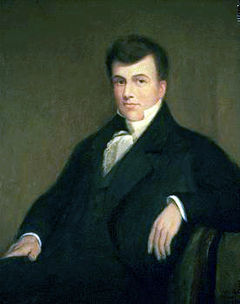Jonathan Jennings
| Jonathan Jennings | |
|---|---|

Official portrait of Jonathan Jennings by James Forbes, based on a small portrait of Jennings painted in 1809.
|
|
| 1st Governor of Indiana | |
|
In office December 12, 1816 – September 12, 1822 |
|
| Lieutenant |
Christopher Harrison Ratliff Boon |
| Preceded by |
Thomas Posey as Territorial Governor |
| Succeeded by | Ratliff Boon |
| Member of the U.S. House of Representatives from Indiana's 1st district | |
|
In office December 2, 1822 – March 3, 1831 |
|
| Preceded by | William Hendricks |
| Succeeded by | John Carr |
| Delegate to the U.S. House of Representatives from Indiana Territory | |
|
In office November 27, 1809 – December 11, 1816 |
|
| Preceded by | Jesse B. Thomas |
| Succeeded by | William Hendricks |
| Personal details | |
| Born | March 27, 1784 Readington, New Jersey |
| Died | July 26, 1834 (aged 50) Charlestown, Indiana |
| Political party | Democratic-Republican |
| Spouse(s) | Ann Gilmore Hay |
| Children | none |
| Profession |
lawyer farmer politician |
| Religion | Presbyterian |
| Signature |  |
Jonathan Jennings (March 27, 1784 – July 26, 1834) was the first governor of Indiana and a nine-term congressman from Indiana. Born in either Hunterdon County, New Jersey, or Rockbridge County, Virginia, he studied law before immigrating to the Indiana Territory in 1806. Jennings initially intended to practice law, but took jobs as an assistant at the federal land office at Vincennes and assistant to the clerk of the territorial legislature to support himself, and pursued interests in land speculation and politics. Jennings became involved in a dispute with the territorial governor, William Henry Harrison, that soon led him to enter politics and set the tone for his early political career. In 1808 Jennings moved to the eastern part of the Indiana Territory and settled near Charlestown, in Clark County. He was elected as the Indiana Territory's delegate to the U.S. Congress by dividing the pro-Harrison supporters and running as an anti-Harrison candidate. By 1812 he was the leader of the anti-slavery and pro-statehood faction of the territorial government. Jennings and his political allies took control of the territorial assembly and dominated governmental affairs after the resignation of Governor Harrison in 1812. As a congressional delegate Jennings aided passage of the Enabling Act in 1816, which authorized the organization of Indiana's state government and state constitution. He was elected president of the Indiana constitutional convention, held in Corydon in June 1816, where he helped draft the state's first constitution. Jennings supported the effort to ban slavery in the state and favored a strong legislative branch of government.
In August 1816 Jennings was elected to serve as the first governor of Indiana at age 32, and re-elected for an additional term. He pressed for the construction of roads and schools, and negotiated the Treaty of St. Mary's to open up central Indiana to American settlement. His opponents attacked his participation in the treaty negotiations as unconstitutional and brought impeachment proceedings against him, a measure that was narrowly defeated by a vote of 15 to 13 after a month-long investigation and the resignation of the lieutenant governor. During his second term and following the panic of 1819, Jennings encountered financial problems, a situation exacerbated by his inability to keep up with his business interests and run the state government simultaneously. Ineligible for another term as Indiana governor under the state constitution, Jennings looked for other means of financial support. Shortly before completion of his second term as governor in 1822, Jennings was elected to the U.S. House of Representatives, before retiring from public service in 1831. In Congress Jennings promoted federal spending on internal improvements.
...
Wikipedia
